 7rv19228-nr25
7rv19228-nr25 
I bought a new lens last week, and as one does, I took it out to take some photos.
This new lens is the Sony 20-70mm f4 G. It’s an interesting spin on the 24-70mm zoom which has been a photographer’s lens of choice for closer work for many years. 20mm is appreciably wider than 24mm. To give it a bit of a challenge, I took it to the National Gallery of Victoria, partly to see if f/4 was going to be a limitation (the professional choice for a 24-70mm is usually f/2.8, and Sony released a very good 24-70mm f/2.8 GM II zoom not long ago). One big advantage to the 20-70 is that it is quite a bit lighter (488g vs 695g) than the 24-70 GM II. It’s also smaller, and it’s quite a bit cheaper, too!
I took this photograph in the foyer of the NGV. It was not a particular simple shot, because I was photographing a silver and gold statue in slightly subdued lighting, backlit by a sunny day coming through the famous glass wall (the glass wall at the front of the gallery has a layer of water running over it). I liked the almost painterly look of the glass backdrop, but it meant the statue was almost a silhouette, and I wanted to bring up the silver and gold look.
I brought the image into Adobe Camera RAW, and got aggressive with my favourite sliders: I raised blacks by 20%, shadows by 80%, and dropped highlights 15%. Considering the image was shot at f/8, 1/2000 (to freeze the water ripples) and ISO 10000, that huge lift in the shadows to bring up the silver and gold was accompanied by a whole bunch of colour noise.
I tried processing the image normally, and saved the results, but I’d heard that Adobe just added a new de-noise algorithm and thought “here’s a good example to test it on!”. I’ve previously used DxO’s Deep Prime processing on noisy photos because I was not impressed with the previous de-noise processing in Adobe Camera RAW, but reports were that the new Adobe processing was even better than Deep Prime. So here is my test.
I’ve included four images in the gallery below. The first is the original full frame (no de-noise processing), scaled to 2500 pixels high. It’s not awful, all things considered! Scaling an image from the A7RV down from 9504 pixels to 2500 pixels cleans up a lot of noise, which is one of the less-commonly mentioned advantages of using a 60 Mpixel sensor. However, the second image is a 100% crop of the golden wheel near the base of the statue, so you can see how much noise there was before the scaling. It may not look too bad in the post, so click on the gallery to see it, then click again to see it larger, and appreciate the noise! The third image in the gallery is a similar crop after running the same RAW image, with the same extreme push of the shadows, through Adobe Camera RAW’s new AI de-noise feature, and the fourth image is the scaled version of the full frame of the de-noised image. My initial reaction to the first image was “that’s not bad”, but the de-noised version looks shinier, and we all know shiny is good!




It did take 25 seconds to process the image on a Mac Studio with an M1 Max chip in it, so I’d think twice about running a whole shoot through it, but for a single image shot in challenging lighting, that’s no problem at all.
I’m impressed. I think I’ll be using this again.